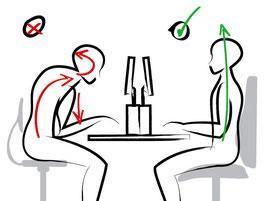5 Alexander Technique Exercises
5 Alexander Technique Exercises
When you see the word exercise, do you imagine exercises like lifting weights, jogging, or calisthenics?
Those exercises increase strength and endurance, and you can use the Alexander Technique as you do them, but Alexander Technique exercises have different goals.
Alexander Technique exercises reduce stress and tension, rather than increase it.
“No pain—Only gain.”
Alexander Technique exercises require a healthy dose of thinking, as do math exercises, writing exercises, music exercises, painting, pottery, memory, acting, and vocabulary exercises. You can create an exercise in any area in which you are attempting to develop a skill. Alexander Technique exercises improve the skill of living—day to day, moment to moment.
There are countless Alexander Technique exercises. Here are five, but notice the exercises embedded within the exercises.
1. Stand up
Standing up is an Alexander Technique exercise in reducing tension during this common, routine action.
Before you stand up, just sit—because even the idea, the thought of standing produces early, preparatory, unnecessary tension.
Let go of the muscular tension in you neck, and notice that your head rotates forward, and goes up. Your head brings your spine up with it. Oppositionally, let your sit bones release down into the chair.
Now for the rising-up part:
Move your feet back a bit. Hinge forward using your hip joints. Your hip joints are where your legs meet your torso. When your weight us sufficiently over your feet, send your feet into the floor and come up to your full height.
There’s no need to use neck tension, or lower back tension. There’s no need to crane your neck, or arch your lower back.
Repeat this exercise 2,846 times over the next few months.
This isn’t typical exercise; this is an Alexander Technique exercise—a mindful exercise and an exercise in mindfulness. Meditation for the body.
2. Sit down
When standing, notice if your knees are locked. If they are, let them be soft. Notice your feet on the floor and let go of any gripping, anywhere.
Now for the sitting-down part:
Send your knees forward, and your hip joints back. As you do this seemingly simple movement, notice if your neck and lower back immediately get involved. After your butt reaches the chair wait a second and then hinge back, using your hip joints (not your lower back).
You will no longer heavily plop down into the chair, saving your butt, your back, your neck, and your chair.
Again, this Alexander Technique exercise deals with reducing excess tension as you carry out this everyday action.
3. Fingertips Rule
This Alexander Technique exercise deals with reducing stress when using your hands. Just the act of putting your hands onto the computer keyboard (for example) usually involves way more tension than necessary.
For this exercise, start with your hands by your sides. Commonly, when lifting our hands, we start the movement with the big muscles of the shoulder or arm and tend to hold on to that extra tension—sometimes for hours.
Instead, as you initiate the movement of lifting your hand, imagine lifting your fingertips only. You can practice this freedom-producing exercise anytime you use your hands; countless times per day. Most Alexander Technique exercises can be practiced as you go about your life, so there’s always time for Alexander Technique exercises.
4. Whisper Ahh
On your next exhalation, whisper a long, slow, controlled ahh… When comfortably emptied out, let the air come in through your nose, silently.
Repeat as you read on.
There is no definite starting point when you whisper ahh. It’s a whispered ahh, not a whispered haa. You’re riding on a wave of air.
As you exhale, let your jaw comfortably open. Releasing your jaw can be its own exercise of releasing habitual, excess jaw tension.
When you inhale, your lips gently touch—lips together, teeth apart.
Think of something funny, or pleasant as you do this exercise. This adds ease, openness, and raises your soft palate.
The whispered ah is an Alexander Technique exercise that is relaxing, calming, and stress-reducing. You can do this exercise anytime and anywhere. It’s great to do when you’re feeling nervous or stressed. Some people use it to ease themselves into sleep. There is never a wrong time for the whispered ahh.
5. Constructively Resting
Here’s an easy Alexander Technique exercise—just lie down. That’s it? That’s it.
You don’t do constructive rest on a bed, or a couch. It’s done on a hard surface—a floor is good, and there’s usually one right beneath your feet. A carpeted floor or any floor with a yoga mat will do. Instead of using a pillow as you would for sleeping, put a few paperback books under you head. Your hands can be by your sides, or on your stomach.
Bend your knees, and have your feet flat on the floor. Let gravity take over, and your torso will lengthen and widen.
Constructive rest pairs nicely with the whispered ahh.
Just 10-15 minutes per day of constructive rest can help greatly.
You will get the maximum benefit from these and other Alexander Technique exercises with the help of an Alexander Technique teacher. I hope you’ll exercise your good judgment and find one.
by Mark Josefsberg
Be the first to post a message!
